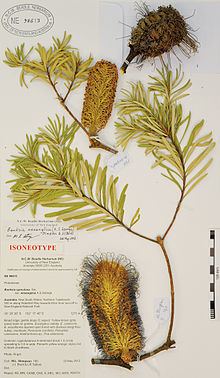Kingdom Plantae Family Proteaceae Species B. neoanglica | Order Proteales Genus Banksia Rank Variety | |
 | ||
Similar Banksia spinulosa var cunni, Banksia spinulosa var spinu, Banksia spinulosa var collina, Banksia dryandroides, Banksia sect Oncostylis | ||
Banksia neoanglica (formerly Banksia spinulosa var. neoanglica, commonly known as New England Banksia), is a shrub that grows along the east coast of Australia, in Queensland and New South Wales.
Contents
Description
As with the other varieties of B. spinulosa (Hairpin Banksia), B. spinulosa var. spinulosa grows as a shrub with flower spikes that are all golden or golden with red or purple styles. Its leaves, flowers and fruit are all very similar to those of B. spinulosa var. cunninghamii, from which it differs in having a lignotuber.
Taxonomy
B. spinulosa var. neoanglica was collected numerous times before 1988, but was not recognised as a distinct taxon until 2012. During collection for The Banksia Atlas project, volunteer collectors reported populations of B. spinulosa in northern New South Wales that were indistinguishable from B. spinulosa var. cunninghamii by their leaves, flowers and fruit, but unlike that variety it had a lignotuber. In 1988, Alex George decided to recognise these populations as a distinct taxon. He published B. spinulosa var. neoanglica based on a specimen collected on 6 April 1986 by Stephen Chapman Clemesha, from a location on the Ebor-Armidale Road, about a kilometre north of the turnoff to New England National Park. He gave it the specific epither neoanglica from the Latin neo ("new"), and anglica (England), in reference to the fact that its centre of distribution is in the New England Tableland.
At the time of publication, B. spinulosa then comprised four varieties. Under George's arrangement of Banksia, the species was placed in Banksia subgenus Banksia, section Oncostylis, series Spicigerae because its inflorescences are cylindrical. B. collina and B. cunninghamii were demoted to varieties of B. spinulosa, and as a result the name B. spinulosa var. spinulosa was used for the first time.
In 1996, Kevin Thiele and Pauline Ladiges published a new arrangement for the genus, after cladistic analyses yielded a cladogram significantly different from George's arrangement. Thiele and Ladiges' arrangement retained B. spinulosa var. neoanglica as a distinct taxon, placing it between B. spinulosa var. collina and B. spinulosa var. cunninghamii. They also retained B. spinulosa in series Spicigerae, but placed the species alone in B. subser. Spinulosae. This arrangement stood until 1999, when George effectively reverted to his 1981 arrangement in his monograph for the Flora of Australia series.
Under George's taxonomic arrangement of Banksia, B. spinulosa var. neoanglica's taxonomic placement may be summarised as follows:
Genus Banksia Subgenus Banksia Section Banksia Section Coccinea Section Oncostylis Series Spicigerae B. spinulosa B. spinulosa var. spinulosa B. spinulosa var. collina B. spinulosa var. neoanglica B. spinulosa var. cunninghamii B. ericifolia B. verticillata B. seminuda B. littoralis B. occidentalis B. brownii Series Tricuspidae Series Dryandroidae Series Abietinae Subgenus IsostylisSince 1998, Austin Mast has been publishing results of ongoing cladistic analyses of DNA sequence data for the subtribe Banksiinae. His analyses suggest a phylogeny that is greatly different from George's arrangement. George's and Thiele and Ladiges' positioning of B. spinulosa var. neoanglica within B. spinulosa is supported, but B. spinulosa's placement is not. Series Spicigerae appears to be polyphyletic, with B. spinulosa and B. ericifolia more closely related to the taxa in Series Salicinae than it is to the other members of series Spicigerae. Early in 2007, Mast and Thiele initiated a rearrangement of Banksia by merging Dryandra into it, and publishing B. subg. Spathulatae for the species having spoon-shaped cotyledons. They foreshadowed publishing a full arrangement once DNA sampling of Dryandra was complete; in the meantime, if Mast and Thiele's nomenclatural changes are taken as an interim arrangement, then B. spinulosa var. neoanglica is placed in B. subg. Spathulatae.
The New South Wales herbarium persists in ranking B. spinulosa var. cunninghamii at species rank, and consider this variety to be a subspecies of it. No name for this subspecies has been formally published; it is usually referred to by the informal name Banksia cunninghamii subsp. A.
It is closely related genetically to the critically endangered Banksia vincentia.
Distribution and habitat
This variety occurs in the New England Tableland and nearby mountainous regions of northern New South Wales.
Cultivation
It is not often cultivated. Alex George suggests that it is probably similar to B. spinulosa var. spinulosa in cultivation, but should tolerate colder conditions.
